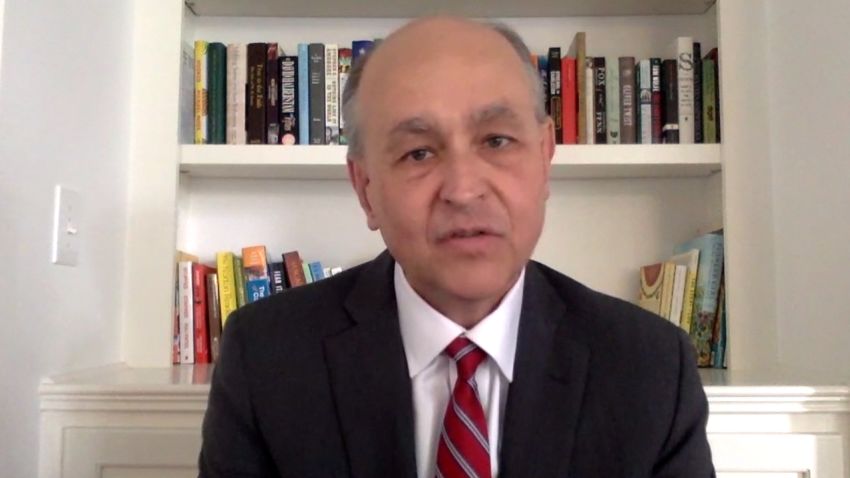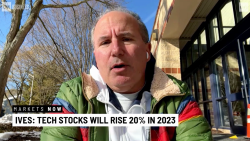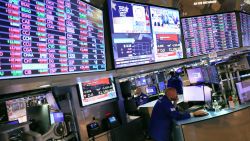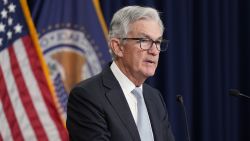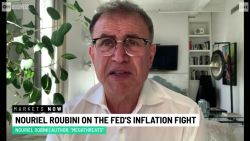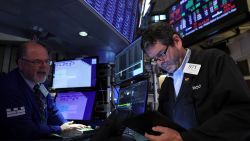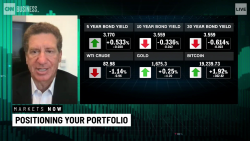A version of this story first appeared in CNN Business’ Before the Bell newsletter. Not a subscriber? You can sign up right here. You can listen to an audio version of the newsletter by clicking the same link.
The US dollar is rising at a blistering clip, reaching its strongest level against other major currencies in almost two decades.
That’s helpful for American tourists traveling abroad this summer. But on Wall Street, it’s growing cause for concern.
“A very strong US dollar provides yet another headwind for earnings,” Morgan Stanley equity strategist Michael Wilson told clients this week.
The US Dollar Index has shot up 4% in the past month and nearly 13% year-to-date, while other top currencies have suffered.
The euro has dropped 12% this year. On Tuesday, it hit parity with the US dollar for the first time in 20 years as fears about the region’s economy — stoked by Russia’s war in Ukraine — push investors to dump their holdings. The pound has retreated toward levels seen during the worst days of the pandemic.
The dollar’s ascent began in anticipation of interest rate hikes by the Federal Reserve, which make the United States a more attractive place to park cash. But in recent weeks, the dollar has dominated for other reasons.
First, there’s its reputation as a safe haven investment. When anxiety builds about the health of the global economy, and the likelihood of a recession increases, investors rush to scoop up dollars as a store of value.
“In the current atmosphere of risk aversion in markets, the US dollar rally is likely to continue in the near term,” Mark Haefele, chief investment officer at UBS Global Wealth Management, said in a recent research note.
Other traditional safe haven currencies aren’t getting the same boost. The Swiss franc is up nearly 8% this year. Japan’s yen has been volatile and recently hit its weakest level against the dollar since 1998.
That’s in part because the US economy looks stronger than its peers, another major driver of the dollar’s climb.
Europe is dealing with a growing energy crisis that could make it much harder for the European Central Bank to fight inflation. Some officials are worried that the crucial Nord Stream 1 pipeline from Russia to Germany, which is closed for routine maintenance, may not restart as normal later this month. That could force governments to make emergency interventions.
“A scenario where the euro area has to ration gas supplies to industry — if that’s not an economic crisis, what is?” Jordan Rochester, currency strategist at Nomura, said Tuesday. He predicted the euro will keep falling.
The United Kingdom, meanwhile, is paralyzed by a political vacuum as the race to replace Boris Johnson as prime minister kicks off, and Japan appears locked in to super-easy monetary policy, opting to prop up the economy instead of putting a lid on price increases.
What it all means: A stronger dollar gives Americans more spending power when they’re outside the country. But as Wilson noted, it’s not necessarily a good thing for stocks, since it eats into the value of Corporate America’s international sales and profits.
US firms generate about 30% of their sales abroad, he calculated. And at a time when they’re already dealing with the effects of inflation, extra inventory and shifts in demand, it’s an additional drag.
“This dollar strength is just another reason to think earnings revisions are coming down over the next few earnings seasons,” Wilson said. “Therefore, the recent rally in stocks is likely to fizzle out before too long.”
China tries to stem growing anger over frozen bank deposits
Protests outside banks from depositors demanding their money back aren’t typically a sign that an economy is running smoothly — hence the concern that recent demonstrations in China may indicate deeper problems.
The latest: Authorities said late Monday that they will start refunding bank customers whose accounts have been frozen for months after a mass protest on Sunday in the central Henan province was crushed violently by authorities.
It was the largest action yet by depositors, who have been fighting for months to retrieve their frozen savings.
Customers from four rural banks in Henan, and one in the neighboring Anhui province, will be repaid starting Friday, according to provincial financial regulators. The first payments will be sent to customers with a combined amount of less than 50,000 yuan ($7,445) on deposit at a single bank.
The rural banks have still not offered a clear explanation as to why and for how long the funds will remain frozen, my CNN Business colleague Laura He reports.
Runs on small Chinese banks have become more frequent in recent years, and some have been accused of financial impropriety or corruption. But experts worry that bigger cracks could be forming, caused by fallout from a real estate crash and soaring bad debts related to the Covid-19 pandemic.
As many as 400,000 customers across China have been unable to access their savings at the rural banks in Henan and Anhui provinces, according to an estimate in April by Sanlian Lifeweek, a state-owned magazine.
That’s a tiny number in the context of China’s vast banking system, but could still present a big risk.
“Despite the small size of the assets involved, the social impact of the incident could be significant if it is not handled appropriately,” said Betty Wang, senior China economist at ANZ.
Klarna has lost 85% of its value in a year
What a difference a year makes for a company like Klarna.
One year ago, the Swedish payments firm was Europe’s hottest startup. It was valued at nearly $46 billion in June 2021 as consumers turned to online shopping during the pandemic and embraced “buy now, pay later” services. A blockbuster initial public offering was in sight, promising a windfall for high-profile backers including SoftBank, Sequoia Capital and SilverLake.
Circumstances have changed dramatically. Klarna announced on Monday that it had raised $800 million in new financing at a valuation of just $6.7 billion. That means 85% of its value has evaporated.
Klarna and its investors said the broader market environment is to blame, not its business model.
“The shift in Klarna’s valuation is entirely due to investors suddenly voting in the opposite manner to the way they voted for the past few years,” Sequoia partner Michael Moritz said. “Eventually, after investors emerge from their bunkers, the stocks of Klarna and other first-rate companies will receive the attention they deserve.”
Klarna now has 150 million users worldwide, almost 30 million of which are in the United States. But in recent months, investors have become skeptical of the fast-growing tech companies they once loved. Instead, they’re doubling down on firms that consistently generate profits.
That’s not Klarna. The company, which has reported steep losses, announced that it was laying off 10% of its workforce in May.
Up next
PepsiCo (PEP) reports earnings before US markets open.
Coming tomorrow: Attention will be laser-focused on the latest consumer inflation data in the United States. Economists polled by Refinitiv expect to learn that prices rose 8.8% in the 12 months to June, an even faster increase than was recorded in May.


